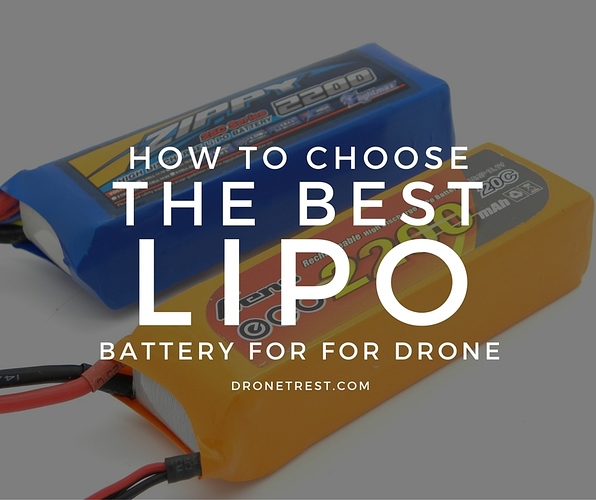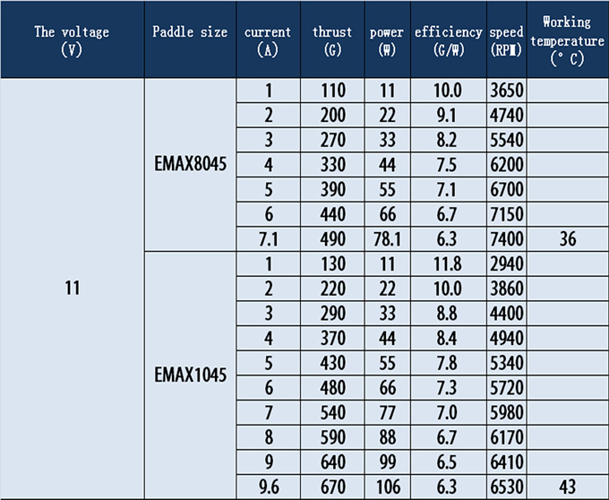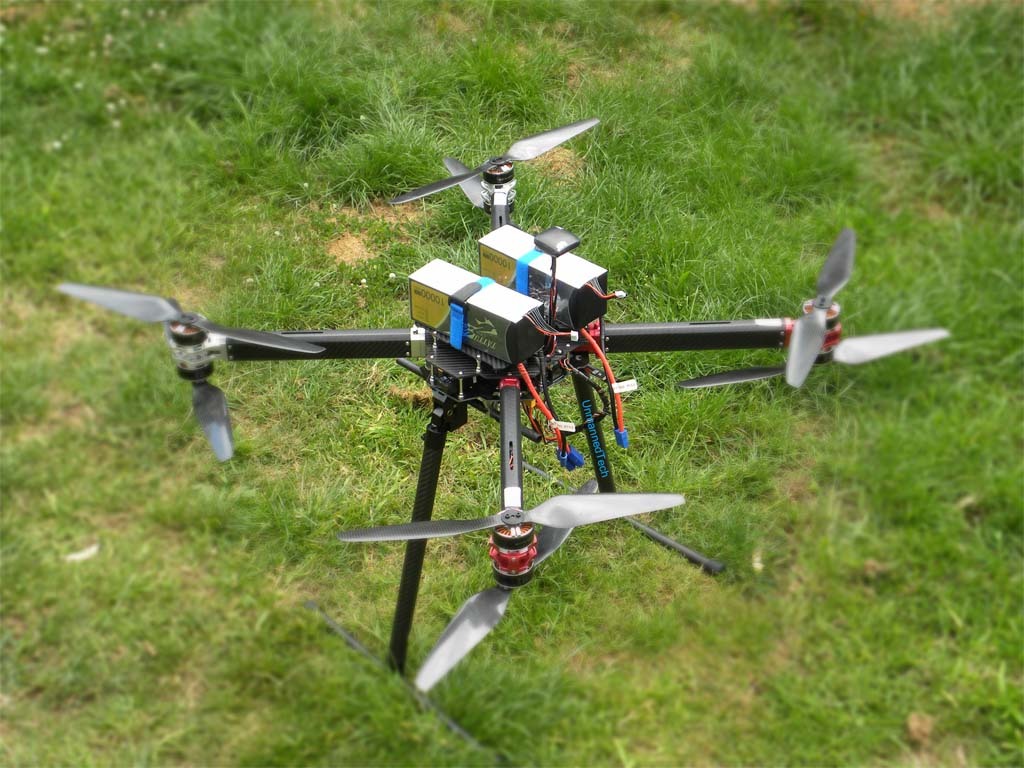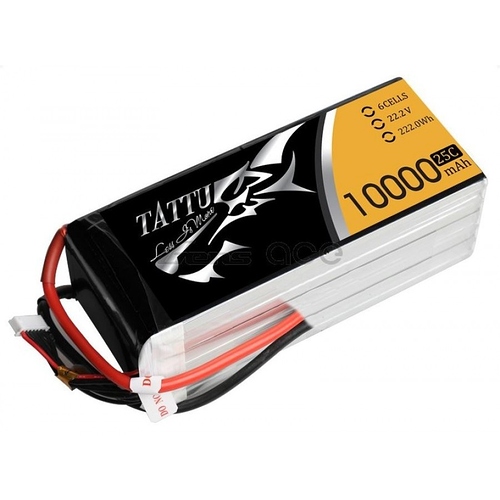In order to get the best flight time and performance it important to know how to go about choosing the best Lipo battery. If you don’t know what a LiPo battery is then its best to check our our Lipo battery guide to learn some of the key concepts and what the numbers mean as I will make use of them in this tutorial.
Like most components on a drone, they are related to other components, and the battery is no exception. The correct battery mainly depends on the size of your drone, and the type and number of motors you use. In this guide we will discuss how to ensure your battery will work properly with your drone system before you buy it.
Knowing what size battery you need
To get the longest flight times you should use the largest battery (in terms of capacity) that you possibly can, but still keep within the maximum takeoff weight of your drone. For more details on finding out what your maximum takeoff weight is for your drone have a look at our guide on how to choose motors, propellers and ESC for your drone. The other thing to take into account is the physical size of the battery, as depending on what drone you are using you will only need be able to fit a battery of a certain size.
Battery Discharge Rate and Capacity
Probably the most important, but often overlooked factor to is the check the battery discharge C rating is the optimum for your drone. Using a discharge rate (C rating) that is too low, can result in your battery being damaged, and your drone under-performing the battery cant release current fast enough to power your motors properly. Since higher C rating batteries are heavier, if the battery you are using has a C rating that is too high, you will just be carrying extra weight around that you dont need, ultimately reducing the flight time.
How to calculate the maximum continuous current output for your battery
In order to know what the total current draw of your drone system is, we cab calculated it based on this simple formula:
Max continous Amp draw (A)
= Battery capacity (Ah) x Discharge rate (C)
For a example, we have a 5100mAh 3 cell Lipo battery with a 10C rating. To find the maximum continuous amp draw, we first convert the 5100mAh to 5.1Ah, and multiply that number by 10C, to give a total continuous output of (5.1 x 10) = 51A
How to find the optimum C rating
As choosing the battery is often the last step to building your own drone, we will already know what motors and ESC we are using. Since the motors will draw the most amount of energy from your battery we can base our calculation around this.
By looking at the specs of your motors, in particular the thrust data tables you will be able to see what the motors maximum current draw is. As an example, our quadcopter (4 motors) weighs about 2Kg in total (with battery and all other equipment), the quadcopter will hover when each motor products about 500g of thrust. Since we are using the MT2213 motors with 10 inch propellers we can look at the thrust table to see the motors current draw at maximum thrust, which turns out to be just under 10A.
Since we are using 4 motors, the total current draw will be about 4 x 10A = 40A Other equipment such as your autopilot and FPV gear will all draw a few miliAmps so their effect can be considered negligible, but to be safe lets add another 1A to the total current draw to round it to 41A. So this will be our maximum current draw during hover. So the 5100mah 10C battery we mentioned previously would work just fine since its current output is 51A, however we could get away with using a lower C rating closer to perhaps 8C to have an even lighter battery. However it is uncommon to find batteries with C ratings lower than 10C.
In order to get the most flight time, we could get a battery with a current output of just over 25A. However in reality we will often fly at higher throttle values during a climb, or if there is a strong wind so at various stages in the flight our current draw might be higher than this, which could damage the battery.
The battery C rating depends on the capacity
There is no fixed C rating that you will need to use as the maximum current output of a battery depends on the capacity and C rating. Typically the smaller the capacity of a battery, the higher the C rating needs to be, this is why for many high capacity multi-rotor batteries you will find very low C ratings in the range of 10-15C.
How much capacity do I need?
Now that you know the required current draw from your battery, the capacity and C rating can be found. In general its best to get teh highest possible capacity battery that you can, which still keeping the total weight of your quadcopter including the battery and other equipment at aroung 50-70% of the maximum motor thrust.
So sticking to our quadcopter example, we know that 50% thrust is around 500g per motor (or 2Kg thrust in total). Our frame, electronics and motors weight come to 1.2Kg. That leaves 800-1000g that we can use for the battery. So you should try to find the highest capacity LiPo that you can find that weights less than this.
Battery Voltage (cell count)
The battery voltage, or cell count is another important decision that you will need to make. Higher voltage batteries allow your motors to produce more power, however the higher voltage batteries are heavier since they contain more cells.
There is no golden rule to follow when it comes to battery voltage, but the way you can find the best voltage for your drone is to look through your motor thrust data tables and compare the efficiency. You will find that motors are generally more efficient and powerful when using higher cell count lipos (higher voltage), but some of the efficiency bonus is negated by the increase in weight and cost of the battery. So depending on how many motors you are using you will need to choose what is best for your current setup.
One thing to bear in mind is to also make sure that your motors/ESC and other electronics are able to support the voltage of your battery. Some motors will only support a specific cell count lipo, or a specific range of voltages which might make the decision easier.
Battery Connectors
Soldering battery connectors can be a real pain, so it is a good idea to try find a battery connector that you like, and stick to it. That allows you to swap batteries easily, and if you decide to build another drone in the future you can use the same batteries. Common connectors include Deans/Tplug, XT60, and also EC3 connectors. For more information on battery connectors and wires check out our connector guide.
Number of batteries
The number of batteries you decide to use on your drone does not ultimately make much difference as there are pros and cons of using more batteries. Firstly using more batteries has an added layer of safety as if one battery should fail, you still have another that you can use to quickly land. Also if you have the flexibility of replacing one battery if one of them gets older than the other. Charging time can be reduced if you have two chargers as each one can charge at the same time. However using two batteries can be more complex to mount and wire and buying two batteries can sometimes be more expensive than buying one. So ultimately using one ore more batteries comes down to the drone your are using and your own preference.
What is the best battery brand?
I am sure that everyone will agree that a battery plays a very important role in your drone system, so here are a few brands that stand out in terms of quality and performance its silly to safe a few pounds ![]() only for your entire drone to crash due to a failed battery . With batteries is is usualy true that you get what you pay for. Some cheaper batteries that may be the same on paper in terms of specifications dont always last as long and the performance starts to drop after several charge/discharge cycles, whereas other top brand batteries take much longer to start showing signs of aging. Also some cheaper batteries experience large voltage drops as the capacity gets low which further reduce flight times. But then again you can argue that a cheaper battery might not last as long, but you can replace it more often since its cheaper. Either way here are a few of our suggested battery brands based on experience.
only for your entire drone to crash due to a failed battery . With batteries is is usualy true that you get what you pay for. Some cheaper batteries that may be the same on paper in terms of specifications dont always last as long and the performance starts to drop after several charge/discharge cycles, whereas other top brand batteries take much longer to start showing signs of aging. Also some cheaper batteries experience large voltage drops as the capacity gets low which further reduce flight times. But then again you can argue that a cheaper battery might not last as long, but you can replace it more often since its cheaper. Either way here are a few of our suggested battery brands based on experience.
GensAce and TATTU batteries
GensAce batteries are one of the top LiPo battery manufacturers around in terms of performance and quality in general. However if you are are after some professional level batteries I can highly recommend the GensAce TATTU series of Lipos. All TATTU batteries have passed the UN 38.3 battery test which is the highest quality standard test for lithium polymer batteries, something that most other manufacturers don’t test. These batteries are abit more expensive that other brands, but they are worth paying abit more for, especially if you are carrying expensive equipment on your drone.
Turnigy/Multistar
Turnigy (hobbyking) are very popular because they offer great performance for very low prices. I have used many of these batteries and they do work well. However these batteries dont seem to hold out as well as gens-ace in terms of charging/discharging cycle life, and voltage drop. But still these batteries are great value for money but better suited for cheaper hobby / beginner drone builds.
Do you have any battery brands that you like to use? Let me know so I can add it to the list.
Looking after your LiPo batteries
Also you should make sure to check out our battery care guide, to ensure your battery will be used safely and last a long time.





 . I often write these guides in parts late at night after work when I get a chance. However we are now focusing more on better written content on the dronetreat blog that gets edited before publishing as I agree it’s not fun to read poorly written guides even if the content is good.
. I often write these guides in parts late at night after work when I get a chance. However we are now focusing more on better written content on the dronetreat blog that gets edited before publishing as I agree it’s not fun to read poorly written guides even if the content is good.